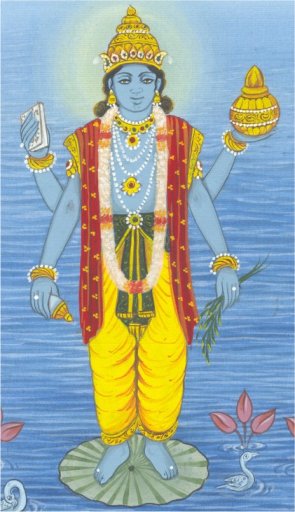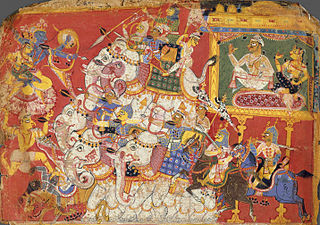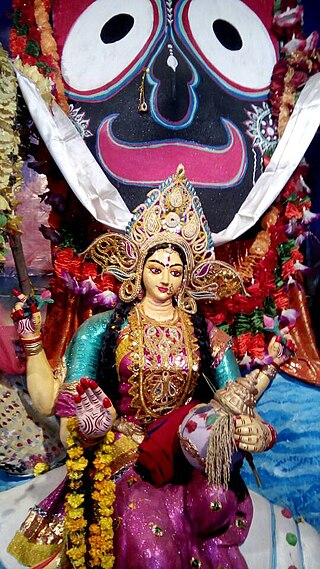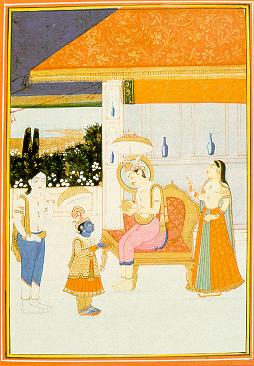
Diwali is the Hindu festival of lights, with variations celebrated in other Indian religions. It symbolises the spiritual "victory of light over darkness, good over evil, and knowledge over ignorance". Diwali is celebrated during the Hindu lunisolar months of Ashvin and Kartika—between around mid-September and mid-November. The celebrations generally last five or six days.

The Mid-Autumn Festival, also known as the Moon Festival or Mooncake Festival, is a harvest festival celebrated in Chinese culture. It is held on the 15th day of the 8th month of the Chinese lunisolar calendar with a full moon at night, corresponding to mid-September to early October of the Gregorian calendar. On this day, the Chinese believe that the moon is at its brightest and fullest size, coinciding with harvest time in the middle of autumn.

Vijayadashami, more commonly known as Dussehra, and also known as Dasara or Dashain, is a major Hindu festival celebrated every year at the end of Durga Puja and Navaratri. It is observed on the tenth day of the month of Ashvin, the seventh in the Hindu lunisolar calendar. The festival typically falls in the Gregorian calendar months of September and October.

Rangoli is an art form that originates from the Indian subcontinent, in which patterns are created on the floor or a tabletop using materials such as powdered lime stone, red ochre, dry rice flour, coloured sand, quartz powder, flower petals, and coloured rocks. It is an everyday practice in many Hindu households, however making it is mostly reserved for festivals and other important celebrations as it is time-consuming. Rangolis are usually made during Diwali or Tihar, Onam, Pongal, and other Hindu festivals in the Indian subcontinent, and are most often made during Diwali. Designs are passed from one generation to the next, keeping both the art form and the tradition alive.

Loy Krathong is a Thai festival celebrated annually throughout Thailand and in nearby countries with significant South Western Tai cultures. The name could be translated as "to float ritual vessel or lamp," and comes from the tradition of making krathong or buoyant, decorated baskets, which are then floated on a river. Many Thais use the krathong to thank the Goddess of Water and River, Goddess Khongkha or to worship the Holy Buddha's hair pagoda in heaven in Buddhist beliefs. This festival traces its origin back to India.

A paper lantern is a lantern made of thin, brightly colored paper. Paper lanterns come in various shapes and sizes, as well as various methods of construction. In their simplest form, they are simply a paper bag with a candle placed inside, although more complicated lanterns consist of a collapsible bamboo or metal frame of hoops covered with tough paper.

Bhai Dooj, Bhai Tika, Bhaubeej, Bhai Beej, Bhai Phonta or Bhratri Dwitiya is a festival celebrated by Hindus on the second lunar day of the Shukla Paksha of Kartika, the eighth month of the Vikram Samvat Hindu calendar or the Shalivahana Shaka calendar. It is celebrated during the Diwali or Tihar festival and Holi festival. The celebrations of this day are similar to the festival of Raksha Bandhan.

Ashvin or Ashwin or Ashwan, also known as Aswayuja, is the seventh month of the lunisolar Hindu calendar, the solar Tamil calendar, where it is known as Aippasi, and the solar Indian national calendar. It is the sixth month of the solar Bengali calendar and the seventh of the lunar Indian calendar of the Deccan Plateau. It falls in the season of Sharada, or autumn. In Hindu astrology, Ashvin begins with the Sun's enter into Virgo.

Kartika Deepam is a festival of lights that is observed mainly by Hindu Tamils, and also by adherents in the regions of Kerala, Andhra Pradesh, Telangana, Karnataka, and Sri Lanka. Celebrated in Tamilakam and Sri Lanka since the ancient period, the festival is held on the full moon day of the Kartika (கார்த்திகை) month, called the Kartika Pournami, falling on the Gregorian months of November or December. It is marked on the day the full moon is in conjunction with the constellation of Kartika. It corresponds to the occasion of the Kartika Purnima, though it falls on a different day due to the correction of equinoxes in the Tamil calendar.

Gudi Padwa is a spring festival marking the start of the lunisolar new year for Hindus, primarily those of the Marathi and Konkani heritage. It is celebrated in and around Maharashtra, Goa & Damaon at the start of Chaitra, the first month of the lunisolar Hindu calendar. The festival is characterised by colourful floor decorations called rangoli, a special gudi dvaja; which is a saari or dhoti or other piece of cloth garlanded with flowers, mango, and neem leaves; a sugar crystal garland called gathi, topped with upturned silver or copper vessels. Celebration also includes street gathering, dancing & festive foods.
Goa is a state of India. Goans are commonly said to be born with music and football in their blood because both are deeply entrenched in Goan culture.

A diya, diyo, deya, deeya, dia, divaa, deepa, deepam, deep, deepak or saaki is an oil lamp made from clay or mud with a cotton wick dipped in oil or ghee. These lamps are commonly used in the Indian subcontinent and they hold sacred prominence in Hindu, Sikh, Buddhist, and Jain prayers as well as religious rituals, ceremonies and festivals including Diwali.
The Konkani people are an Indo-Aryan ethnolinguistic group native to the Konkan region of the Indian subcontinent who speak various dialects of the Konkani language. Konkani is the state language of Goa and also spoken by populations in Karnataka, Maharashtra, Damaon and Kerala. Other Konkani speakers are found in Gujarat state. A large percentage of Konkani people are bilingual.

A sky lantern, also known as Kǒngmíng lantern, or Chinese lantern, is a small balloon made of paper, with an opening at the bottom where a small fire is suspended.

Dhanteras, also known as Dhanatrayodashi, is the first day that marks the festival of Diwali in most of India.

Naraka Chaturdashi is an annual Hindu festival that falls on Chaturdashi of the Krishna Paksha in the Hindu calendar month of Ashvin or Kartika. It is the second day of the five-day long festival of Diwali. Hindu literature narrates that the asura (demon) Narakasura was killed on this day by Krishna and Satyabhama. The day is celebrated by early morning religious rituals, and festivities follow on.

Lakshmi Puja is a Hindu occasion for the veneration of Lakshmi, the goddess of prosperity and the supreme goddess of Vaishnavism. The occasion is celebrated on the amavasya in the Vikram Samvat Hindu calendar month of Ashwayuja or Kartika, on the third day of Deepavali (Tihar) in most part of India and Nepal. In Assam, Bengal, and Odisha, this puja is celebrated five days after Vijaya Dashami.

A sanna is a spongy, steamed, and savoury unfilled dumpling originally made of red rice, black lentil and coconut in the Konkan region, by the western coast of the Indian subcontinent. They originated in Goa and Damaon, Mangalore, Bombay and Bassein (Vasai), and are especially popular among Goans, both the Goan Hindus and Goan Christians, and also among the Konkani migrants outside Konkan in Karachi, Sindh, Gujarat, Karnataka and Kerala. They are also loved by the people of the Konkan division, such as the Kuparis of the Bombay East Indian community.

Balipratipada, also called as Bali-Padyami, Padva, Virapratipada or Dyutapratipada, is the fourth day of Diwali, the Hindu festival of lights. It is celebrated in honour of the notional return of the daitya-king Bali (Mahabali) to earth. Balipratipada falls in the Gregorian calendar months of October or November. It is the first day of the Hindu month of Kartika and is the first day of its bright lunar fortnight. In many parts of India such as Gujarat and Rajasthan, it is the regional traditional New Year Day in Vikram Samvat and also called the Bestu Varas or Varsha Pratipada. This is the half amongst the three and a half Muhūrtas in a year.

The Dev Deepavali is the festival of Kartik Poornima celebrated in the city of Varanasi in Bhojpuri region of Uttar Pradesh, India. It falls on the full moon of the Hindu month of Kartika and takes place fifteen days after Diwali. The steps of all the ghats on the riverfront of the Ganges River, from Ravidas Ghat at the southern end to Rajghat, are lit with more than a million earthen lamps (diyas) in honour of Ganga, the Ganges, and its presiding goddess. Mythologically, the gods are believed to descend to Earth to bathe in the Ganges on this day. The festival is also observed as Tripura Purnima Snan. The tradition of lighting the lamps on the Dev Deepawali festival day was first started at the Dashashwamedh Ghat by Pandit Kishori Raman Dubey in 1991.


















